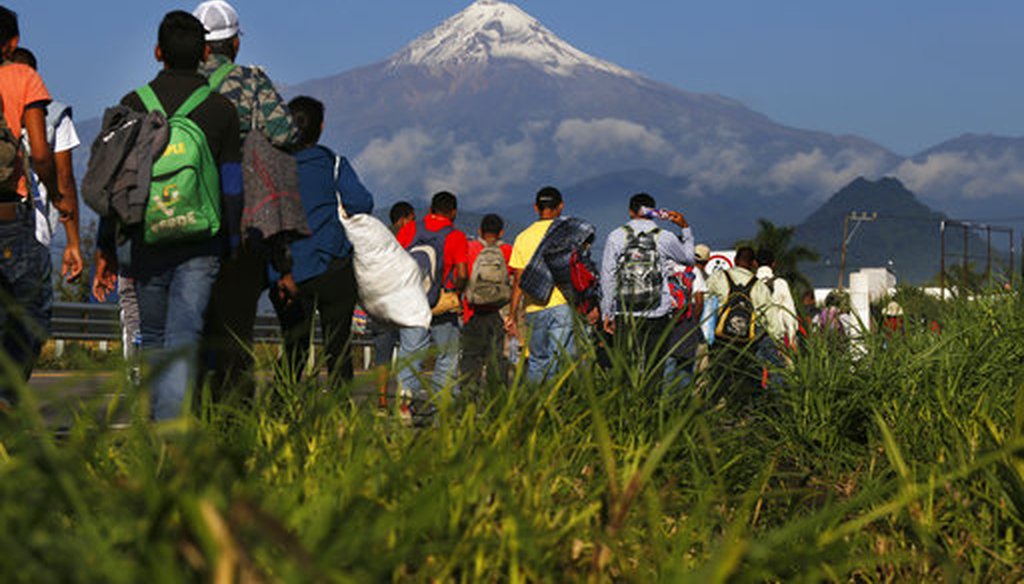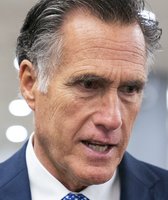Get PolitiFact in your inbox.

Central American migrants begin their morning trek as part of a thousands-strong caravan hoping to reach the U.S. border, as they face the Pico de Orizaba volcano upon departure from Cordoba, Veracruz state, Mexico, Nov. 5, 2018. (AP Photo/Marco Ugarte)
President Donald Trump cast a caravan of Central American migrants walking to the United States as a national threat that required military intervention.
"Many Gang Members and some very bad people are mixed into the Caravan heading to our Southern Border," Trump tweeted Oct. 29. "Please go back, you will not be admitted into the United States unless you go through the legal process. This is an invasion of our Country and our Military is waiting for you!"
The caravan that’s in Mexico City began its journey more than three weeks ago from Honduras. Its size has fluctuated, with estimates of at least 3,500 people in the group. There are reports of smaller caravans also walking north.
Men, women and children are in the caravans and many want to request asylum in the United States. Asking for asylum is allowed under law — whether migrants come in through ports of entry or are intercepted by Border Patrol.
Trump’s likening of the caravan to an invasion is an exaggeration given what we know about the caravan. Several immigration and military experts disputed Trump’s label and questioned the effectiveness of dispatching active-duty military personnel to the southwest border.
Are migrants trying to "invade" the United States?
"Invasions are armed operations organized with the intention of taking control of foreign sovereign territory through the use of force," said Mary Ellen O'Connell, a law professor at the University of Notre Dame, whose expertise includes international law on the use of force and dispute resolution. She cited as an example the 2003 invasion of Iraq by the United States, United Kingdom, and Australia.
"The migrants are not armed, organized, or intending to take control of U.S. territory," O’Connell said.
The Central American caravans coming to the United States "do not represent a national security threat or crisis," and are rather fleeing poverty, violence, and insecurity in their countries, wrote Doris Meissner, former commissioner of the U.S. Immigration and Naturalization Service and senior fellow at the Migration Policy Institute.
The recent numbers of people apprehended at the southwest border also aren’t as high as they were in the early 2000s. Border Patrol apprehensions during that time often surpassed 1 million. Total southwest border apprehensions in fiscal year 2018 were below 400,000.
There’s also a notable difference in the demographics. In the early 2000s, it was mostly Mexican men who were seeking entry. In recent years, Central Americans coming in have outnumbered Mexicans, and a large share are unaccompanied children and families.
The military’s limited role at the border
Marine Corps Gen. Joe Dunford, the chairman of the Joint Chiefs of Staff, said the military will provide logistical assistance to immigration officials, not apprehend immigrants.
"There is no plan for U.S. military forces to be involved in the actual mission of denying people entry to the United States," Dunford said at a Nov. 5 event at Duke University. "There is no plan for soldiers to come in contact with immigrants or to reinforce Department of Homeland Security as they’re conducting their mission."
Soldiers are already at the border putting up concertina wire and reinforcing points of entry, Dunford said.
More than 5,200 troops are expected at the border. Military officials have said it’s uncertain how many in total will be sent or the total costs associated with the mission. Trump has floated the possibility of deploying as many as 15,000 troops.
The active-duty troops are being sent in addition to the more than 2,000 National Guard troops sent earlier this year in response to another caravan. The National Guard troops are providing logistical support, aerial surveillance and repairing border infrastructure.
Response to ‘tough fighters’
Trump tweeted the caravans "are made up of some very tough fighters and people. Fought back hard and viciously against Mexico at Northern Border before breaking through. Mexican soldiers hurt, were unable, or unwilling to stop Caravan."
There were reports of violent clashes among migrants and police officers in Guatemala and Mexico as migrants sought to make their way north. At one point in Mexico, "migrants threw rocks and sticks. Mexican forces threw tear gas," CNN reported Oct. 30.
But that might not be the scenario in the United States, said Theresa Cardinal Brown, director of immigration and cross-border policy at the Bipartisan Policy Center think tank.
"They are trying to come to the U.S. border to apply for asylum, if that is their tactic, I’m not sure why they would be aggressive toward the U.S. government officials," said Brown, who served in the Department of Homeland Security during the George W. Bush and Barack Obama administrations.
Border Patrol agents do run into violent people who engage in drug and human smuggling, but the vast majority of people they encounter aren’t violent, running or hiding from authorities, said Gil Kerlikowske, a U.S. Customs and Border Protection commissioner during the Obama administration. They are often looking for Border Patrol agents.
It’s possible that among caravan members are some people with criminal backgrounds, Kerlikowske said. But there could be varying degrees of crimes committed — having a criminal record for stealing a motorcycle is quite different for having a record for a physical assault, he said.
Border Patrol agents are also highly trained in identifying whether individuals are gang members, through tattoos or other signs, said Kerlikowske, a nonresident fellow at Rice University’s Baker Institute for Public Policy and a professor at Northeastern University.
Experts said the agency goes through extensive training on the appropriate use of force, and that deadly force is the last resort.
"Because the migrants are not an ‘organized armed group’ with weapons, training, and command requisite to engaging U.S. military forces, the U.S. is only permitted under international law to use lethal force under police rules — to save lives immediately," said O’Connell, of the University of Notre Dame. "If a migrant fires a gun at a U.S. service members, that service member may defend herself if a police or border enforcement officer would be able to do in the same circumstance."
If the military uses force, it would be evaluated on whether it was appropriate or was a violation of the rules of engagement, said David Lapan, Bipartisan Policy Center’s vice president of communications and former DHS press secretary in the Trump administration.
It’s unclear which sector of the southwest border the caravans will head to or how many will end up reaching the U.S. border.
Since most are walking, it likely will take them weeks if not months to get to the United States.
Our Sources
Twitter, @realdonaldtrump tweet, Oct. 29, 2018; tweet, Oct. 31, 2018
PolitiFact, Here’s the latest on the migrant caravans, Nov. 2, 2018
PolitiFact, Immigration in 5 charts: a 2018 midterm report, Oct. 7, 2018
CBP.gov, Southwest Border Migration FY2018
Defense.gov, Dunford Discusses Military Support to DHS, Nov. 6 2018
YouTube, Duke University Department of Political Science - Joseph Dunford speaks at Duke University, Nov. 5, 2018
Twitter, @jimsciutto tweet, Nov. 6, 2018
CNN, Mexico walks political tightrope over migrants moving north, Oct. 30, 2018
Migration Policy Institute, Asylum Reform, Not Troops, Is the Solution to Current Border Reality, November 2018
Phone interview, Theresa Cardinal Brown, director of immigration and cross-border policy at the Bipartisan Policy Center think tank, Nov. 5, 2018
Email interview, Mary Ellen O'Connell, a law professor at the University of Notre Dame, Nov. 5, 2018
Phone interview, Gil Kerlikowske, a U.S. Customs and Border Protection commissioner during the Obama administration, Nov. 5, 2018
Phone interview, David Lapan, Bipartisan Policy Center’s vice president of communications and former DHS press secretary under the Trump administration, Nov. 5, 2018








































